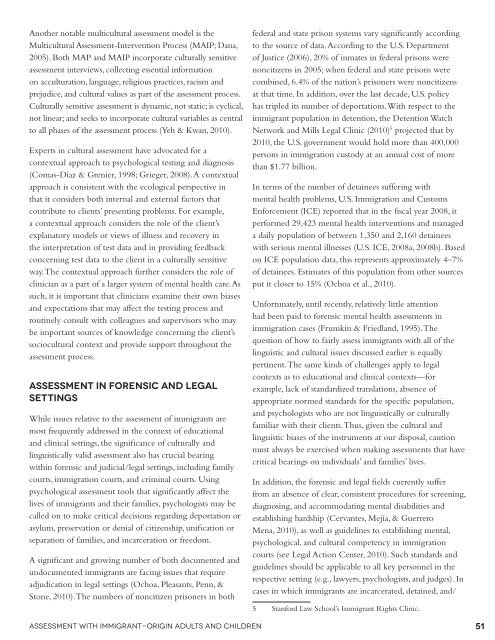Crossroads: The Psychology of Immigration in the New Century
Crossroads: The Psychology of Immigration in the New Century
Crossroads: The Psychology of Immigration in the New Century
Create successful ePaper yourself
Turn your PDF publications into a flip-book with our unique Google optimized e-Paper software.
Ano<strong>the</strong>r notable multicultural assessment model is <strong>the</strong><br />
Multicultural Assessment-Intervention Process (MAIP; Dana,<br />
2005). Both MAP and MAIP <strong>in</strong>corporate culturally sensitive<br />
assessment <strong>in</strong>terviews, collect<strong>in</strong>g essential <strong>in</strong>formation<br />
on acculturation, language, religious practices, racism and<br />
prejudice, and cultural values as part <strong>of</strong> <strong>the</strong> assessment process.<br />
Culturally sensitive assessment is dynamic, not static; is cyclical,<br />
not l<strong>in</strong>ear; and seeks to <strong>in</strong>corporate cultural variables as central<br />
to all phases <strong>of</strong> <strong>the</strong> assessment process (Yeh & Kwan, 2010).<br />
Experts <strong>in</strong> cultural assessment have advocated for a<br />
contextual approach to psychological test<strong>in</strong>g and diagnosis<br />
(Comas-Díaz & Grenier, 1998; Grieger, 2008). A contextual<br />
approach is consistent with <strong>the</strong> ecological perspective <strong>in</strong><br />
that it considers both <strong>in</strong>ternal and external factors that<br />
contribute to clients’ present<strong>in</strong>g problems. For example,<br />
a contextual approach considers <strong>the</strong> role <strong>of</strong> <strong>the</strong> client’s<br />
explanatory models or views <strong>of</strong> illness and recovery <strong>in</strong><br />
<strong>the</strong> <strong>in</strong>terpretation <strong>of</strong> test data and <strong>in</strong> provid<strong>in</strong>g feedback<br />
concern<strong>in</strong>g test data to <strong>the</strong> client <strong>in</strong> a culturally sensitive<br />
way. <strong>The</strong> contextual approach fur<strong>the</strong>r considers <strong>the</strong> role <strong>of</strong><br />
cl<strong>in</strong>ician as a part <strong>of</strong> a larger system <strong>of</strong> mental health care. As<br />
such, it is important that cl<strong>in</strong>icians exam<strong>in</strong>e <strong>the</strong>ir own biases<br />
and expectations that may affect <strong>the</strong> test<strong>in</strong>g process and<br />
rout<strong>in</strong>ely consult with colleagues and supervisors who may<br />
be important sources <strong>of</strong> knowledge concern<strong>in</strong>g <strong>the</strong> client’s<br />
sociocultural context and provide support throughout <strong>the</strong><br />
assessment process.<br />
assessment <strong>in</strong> Forensic and Legal<br />
sett<strong>in</strong>gs<br />
While issues relative to <strong>the</strong> assessment <strong>of</strong> immigrants are<br />
most frequently addressed <strong>in</strong> <strong>the</strong> context <strong>of</strong> educational<br />
and cl<strong>in</strong>ical sett<strong>in</strong>gs, <strong>the</strong> significance <strong>of</strong> culturally and<br />
l<strong>in</strong>guistically valid assessment also has crucial bear<strong>in</strong>g<br />
with<strong>in</strong> forensic and judicial/legal sett<strong>in</strong>gs, <strong>in</strong>clud<strong>in</strong>g family<br />
courts, immigration courts, and crim<strong>in</strong>al courts. Us<strong>in</strong>g<br />
psychological assessment tools that significantly affect <strong>the</strong><br />
lives <strong>of</strong> immigrants and <strong>the</strong>ir families, psychologists may be<br />
called on to make critical decisions regard<strong>in</strong>g deportation or<br />
asylum, preservation or denial <strong>of</strong> citizenship, unification or<br />
separation <strong>of</strong> families, and <strong>in</strong>carceration or freedom.<br />
A significant and grow<strong>in</strong>g number <strong>of</strong> both documented and<br />
undocumented immigrants are fac<strong>in</strong>g issues that require<br />
adjudication <strong>in</strong> legal sett<strong>in</strong>gs (Ochoa, Pleasants, Penn, &<br />
Stone, 2010). <strong>The</strong> numbers <strong>of</strong> noncitizen prisoners <strong>in</strong> both<br />
Assessment With Immigrant-Orig<strong>in</strong> Adults and Children<br />
federal and state prison systems vary significantly accord<strong>in</strong>g<br />
to <strong>the</strong> source <strong>of</strong> data. Accord<strong>in</strong>g to <strong>the</strong> U.S. Department<br />
<strong>of</strong> Justice (2006), 20% <strong>of</strong> <strong>in</strong>mates <strong>in</strong> federal prisons were<br />
noncitizens <strong>in</strong> 2005; when federal and state prisons were<br />
comb<strong>in</strong>ed, 6.4% <strong>of</strong> <strong>the</strong> nation’s prisoners were noncitizens<br />
at that time. In addition, over <strong>the</strong> last decade, U.S. policy<br />
has tripled its number <strong>of</strong> deportations. With respect to <strong>the</strong><br />
immigrant population <strong>in</strong> detention, <strong>the</strong> Detention Watch<br />
Network and Mills Legal Cl<strong>in</strong>ic (2010) 5 projected that by<br />
2010, <strong>the</strong> U.S. government would hold more than 400,000<br />
persons <strong>in</strong> immigration custody at an annual cost <strong>of</strong> more<br />
than $1.77 billion.<br />
In terms <strong>of</strong> <strong>the</strong> number <strong>of</strong> deta<strong>in</strong>ees suffer<strong>in</strong>g with<br />
mental health problems, U.S. <strong>Immigration</strong> and Customs<br />
Enforcement (ICE) reported that <strong>in</strong> <strong>the</strong> fiscal year 2008, it<br />
performed 29,423 mental health <strong>in</strong>terventions and managed<br />
a daily population <strong>of</strong> between 1,350 and 2,160 deta<strong>in</strong>ees<br />
with serious mental illnesses (U.S. ICE, 2008a, 2008b). Based<br />
on ICE population data, this represents approximately 4–7%<br />
<strong>of</strong> deta<strong>in</strong>ees. Estimates <strong>of</strong> this population from o<strong>the</strong>r sources<br />
put it closer to 15% (Ochoa et al., 2010).<br />
Unfortunately, until recently, relatively little attention<br />
had been paid to forensic mental health assessments <strong>in</strong><br />
immigration cases (Frumk<strong>in</strong> & Friedland, 1995). <strong>The</strong><br />
question <strong>of</strong> how to fairly assess immigrants with all <strong>of</strong> <strong>the</strong><br />
l<strong>in</strong>guistic and cultural issues discussed earlier is equally<br />
pert<strong>in</strong>ent. <strong>The</strong> same k<strong>in</strong>ds <strong>of</strong> challenges apply to legal<br />
contexts as to educational and cl<strong>in</strong>ical contexts—for<br />
example, lack <strong>of</strong> standardized translations, absence <strong>of</strong><br />
appropriate normed standards for <strong>the</strong> specific population,<br />
and psychologists who are not l<strong>in</strong>guistically or culturally<br />
familiar with <strong>the</strong>ir clients. Thus, given <strong>the</strong> cultural and<br />
l<strong>in</strong>guistic biases <strong>of</strong> <strong>the</strong> <strong>in</strong>struments at our disposal, caution<br />
must always be exercised when mak<strong>in</strong>g assessments that have<br />
critical bear<strong>in</strong>gs on <strong>in</strong>dividuals’ and families’ lives.<br />
In addition, <strong>the</strong> forensic and legal fields currently suffer<br />
from an absence <strong>of</strong> clear, consistent procedures for screen<strong>in</strong>g,<br />
diagnos<strong>in</strong>g, and accommodat<strong>in</strong>g mental disabilities and<br />
establish<strong>in</strong>g hardship (Cervantes, Mejía, & Guerrero<br />
Mena, 2010), as well as guidel<strong>in</strong>es to establish<strong>in</strong>g mental,<br />
psychological, and cultural competency <strong>in</strong> immigration<br />
courts (see Legal Action Center, 2010). Such standards and<br />
guidel<strong>in</strong>es should be applicable to all key personnel <strong>in</strong> <strong>the</strong><br />
respective sett<strong>in</strong>g (e.g., lawyers, psychologists, and judges). In<br />
cases <strong>in</strong> which immigrants are <strong>in</strong>carcerated, deta<strong>in</strong>ed, and/<br />
5 Stanford Law School’s Immigrant Rights Cl<strong>in</strong>ic.<br />
51
















